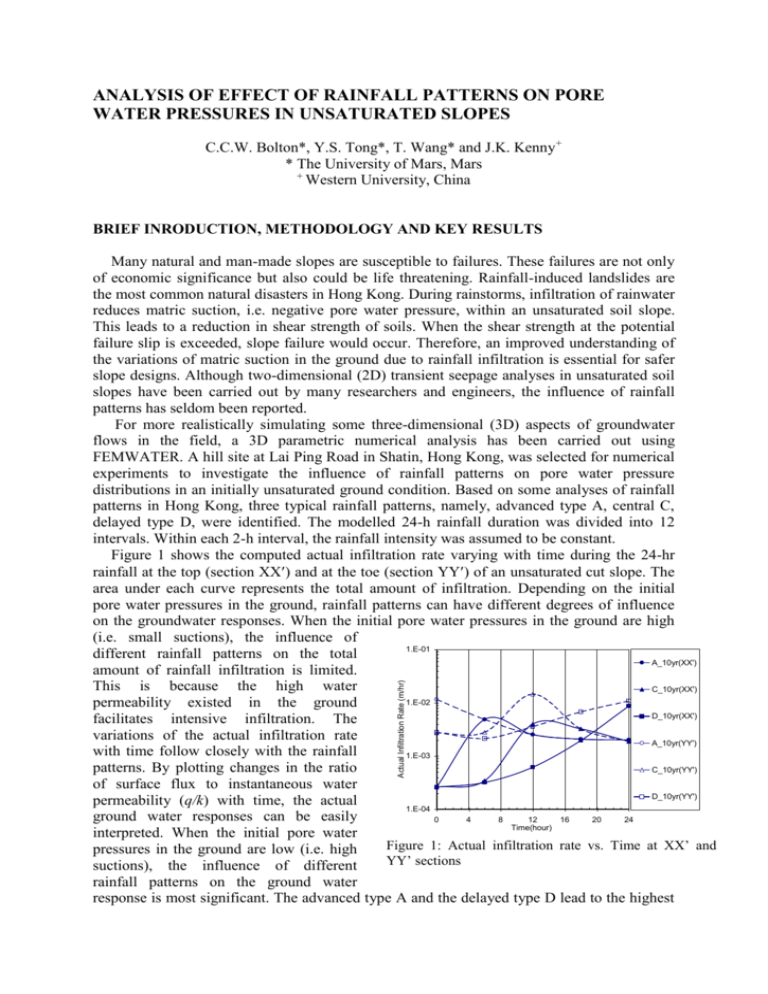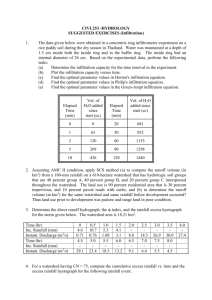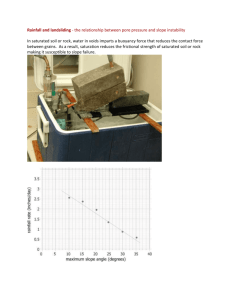example - GeGe 2015
advertisement

ANALYSIS OF EFFECT OF RAINFALL PATTERNS ON PORE WATER PRESSURES IN UNSATURATED SLOPES C.C.W. Bolton*, Y.S. Tong*, T. Wang* and J.K. Kenny+ * The University of Mars, Mars + Western University, China BRIEF INRODUCTION, METHODOLOGY AND KEY RESULTS Actual Infiltration Rate (m/hr) Many natural and man-made slopes are susceptible to failures. These failures are not only of economic significance but also could be life threatening. Rainfall-induced landslides are the most common natural disasters in Hong Kong. During rainstorms, infiltration of rainwater reduces matric suction, i.e. negative pore water pressure, within an unsaturated soil slope. This leads to a reduction in shear strength of soils. When the shear strength at the potential failure slip is exceeded, slope failure would occur. Therefore, an improved understanding of the variations of matric suction in the ground due to rainfall infiltration is essential for safer slope designs. Although two-dimensional (2D) transient seepage analyses in unsaturated soil slopes have been carried out by many researchers and engineers, the influence of rainfall patterns has seldom been reported. For more realistically simulating some three-dimensional (3D) aspects of groundwater flows in the field, a 3D parametric numerical analysis has been carried out using FEMWATER. A hill site at Lai Ping Road in Shatin, Hong Kong, was selected for numerical experiments to investigate the influence of rainfall patterns on pore water pressure distributions in an initially unsaturated ground condition. Based on some analyses of rainfall patterns in Hong Kong, three typical rainfall patterns, namely, advanced type A, central C, delayed type D, were identified. The modelled 24-h rainfall duration was divided into 12 intervals. Within each 2-h interval, the rainfall intensity was assumed to be constant. Figure 1 shows the computed actual infiltration rate varying with time during the 24-hr rainfall at the top (section XX) and at the toe (section YY) of an unsaturated cut slope. The area under each curve represents the total amount of infiltration. Depending on the initial pore water pressures in the ground, rainfall patterns can have different degrees of influence on the groundwater responses. When the initial pore water pressures in the ground are high (i.e. small suctions), the influence of 1.E-01 different rainfall patterns on the total A_10yr(XX') amount of rainfall infiltration is limited. This is because the high water C_10yr(XX') 1.E-02 permeability existed in the ground D_10yr(XX') facilitates intensive infiltration. The variations of the actual infiltration rate A_10yr(YY') with time follow closely with the rainfall 1.E-03 patterns. By plotting changes in the ratio C_10yr(YY') of surface flux to instantaneous water D_10yr(YY') permeability (q/k) with time, the actual 1.E-04 ground water responses can be easily 0 4 8 12 16 20 24 Time(hour) interpreted. When the initial pore water Figure 1: Actual infiltration rate vs. Time at XX’ and pressures in the ground are low (i.e. high YY’ sections suctions), the influence of different rainfall patterns on the ground water response is most significant. The advanced type A and the delayed type D lead to the highest and the lowest rate of infiltration and total amount of infiltration, respectively. This implies that former pattern will be the most critical one for slope instability. CONCLUSIONS 1. A series of 3D transient analyses were carried out to investigate the influence of rainfall patterns on pore water distributions in unsaturated soil slopes. Three typical rainfall patterns in Hong Kong were modelled. Depending on the initial pore water pressures in the ground, rainfall patterns can have different degrees of influence on the groundwater responses. When the initial pore water pressures in the ground are high (i.e. small suctions), the influence of different rainfall patterns on the total amount of rainfall infiltration is limited. This is because the high water permeability existed in the ground facilitates intensive infiltration. The variations of the actual infiltration rate with time follow closely with the rainfall patterns. By plotting changes in the ratio of surface flux to instantaneous water permeability (q/k) with time, the actual ground water responses can be easily interpreted. 2. When the initial pore water pressures in the ground are low (i.e. high suctions), the influence of different rainfall patterns on the ground water response is most significant. The advanced type A and the delayed type D lead to the highest and the lowest rate of infiltration and total amount of infiltration, respectively. This implies that former pattern will be the most critical one for slope instability. ACKNOWLEDGEMENTS This research project is financially supported by the research grant XYZ provided by the Research Grants Council of the Mars Government. REFERENCES Finlay, P. J., Fell, R., and Maguire, P. K. (1997). “The relationship between the probability of landslide occurrence and rainfal.” Can. Geotech. J. 34, pp. 811-824. Fourie, A. B., Rowe D. and Blight, G. E. (1997). “The effect of infiltration on the stability of the slopes of a dry ash dump.” Geotechnique 49, No. 1, pp. 1-13. Kasim, F. B., Fredlund, D. G., and Gan, J. K-M. (1998). “Effects of Steady State Rainfall on Long Term Matric Suction on Conditions in Slopes.” Unsat. 98, Beijing, Vol. 1, pp. 78 – 83. Rahardjo, H. and Leong, E. C. (1997). “Soil water characteristic curves and flux boundary problems.” Unsaturated Soil Engineering Practice, Geotechnical Special Publication No. 68. ASCE, pp. 88-112. Wilson, G. W. (1997). “Surface flux boundary modelling for unsaturated soils.” Unsaturated Soil Engineering Practice, Geotechnical Special Publication No. 68. ASCE, pp. 38-67.






